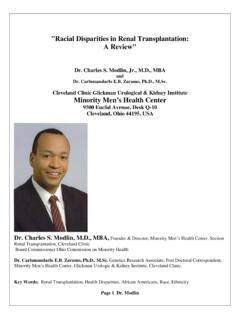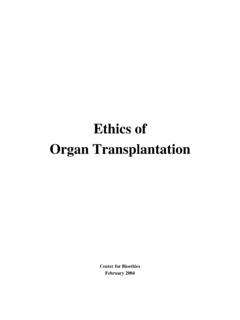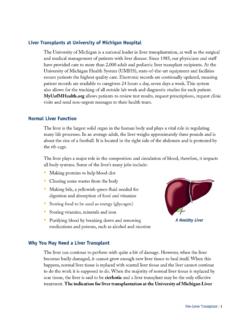Transcription of Transplantation Immunology Types of Grafts
1 1 Transplantation ImmunologyMitchell S. Cairo, MDProfessor of Pediatrics, Medicine and PathologyChief, Division, Pediatric Blood & Marrow TransplantationChildren s Hospital New York PresbyterianTel 212-305-8316 Fax 212-305-8428E-mail Understand the immunological mechanisms responsible for first and second set allograft skin rejectionCt liditd i dit lltiObjectives Conceptualize direct and indirect alloantigen recognition Learn the definition and mechanism(s) associated with the mixed lymphocyte reaction (MLR) Distinguish and compare the pathological mechanisms and description of hyperacute, acute and chronic solid organ vs.
2 Bone marrow allograft rejection Begin to understand the mechanisms of central andObjectives Begin to understand the mechanisms of central and peripheral immunological tolerance Appreciate the general & specific indication for bone marrow Transplantation and essential components for development of graft vs. host disease (GVHD) Types of Grafts Autologous (self) , BM, peripheral blood stem cells, skin, bone Syngeneic (identical twin) Allogeneic (another human except identical twin) Xenogeneic (one species to another)Innate & Adaptive ImmunityDranoff et al Nature Reviews Cancer, 4: 11; 2004 Rejection First Set Rejection Skin graft in mice 7-10 days Second Set Rejection Skin graft in mice in 2-3 daysMechanisms Foreign alloantigen recognition Memory lymphocytes (adaptive immunity) Can be adoptively transferred2 MHC Restricted Allograft RejectionFirst & Second Allograft RejectionAlloAntigen Recognition Major Histocompatibility Complex (MHC) Class I HLA A, B, C bind to TCR on CD8 T-Cell Class II DR, DP, DQ bind to TCR on CD4 T-Cell Most polymorphic genes in human genome Co-dominantly expressed Co-dominantly expressed Direct presentation (Donor APC)
3 Unprocessed allogeneic MHC Indirect presentation (Host APC) Processed peptide of allogeneic MHCMap of Human MHCT-Cell Recognition of Peptide-MHC ComplexDevelopmental Dendritic Cell FormationWu et al Immunity, 20073 Direct and Indirect AlloAntigen RecognitionRegulation of T-cell Activation and Tolerance by B7- CD28/CTLA-4 PathwaySharpe et al, NEJM, 2006 Antigen Recognition & Immunological SynapseMixed Lymphocyte Reaction(MLR) In vitrotest of T-cell regulation of allogeneic MHC Stimulators (donor-irradiated monnuclear cells) Responders (recipient mononuclear cells) Definition & Mechanism Measure proliferative response of responders (tritiated thymidine incorporation) Can be adoptively transferred Require co-stimulation Require MHC Require Class I differences for CD8 T-cell response Require Class II differences for CD4 T-cell response RequirementsMixed Lymphocyte Reaction (MLR)Pathological Mechanism of Rejection Hyperacute Minutes to hours Preexisting antibodies (IgG)
4 Intravascular thrombosis Hx of blood transfusion, Transplantation or multiple pregnanciesAtRjtiNot Applicable PiG ftF ilSolid OrganBone Marrow/PBSC Acute Rejection Few days to weeks CD4 + CD8 T-Cells Humoral antibody response Parenchymal damage & Inflammation Chronic Rejection Chronic fibrosis Accelerated arteriosclerosis 6 months to yrs CD4, CD8, (Th2) Macrophages Primary Graft Failure 10 30 Days Host NK Cells Lysis of donor stem cells Secondary Graft Failure 30 days 6 months Autologous T-CellsCD4 + CD8-Lysis of donor stem cells4 Immune Mechanisms of Solid Organ Allograft RejectionHyperacute, Acute, Chronic Kidney Allograft RejectionHyperacuteAcuteAcuteChronicMech anisms of Acute Allograft RejectionPrevention & Treatment of Allograft Rejection ABO Compatible(Prevent hyperacute rejection in solid organs)(Prevent transfusion reaction in BM/PBSC)
5 MHC allele closely matched Calcineurin inhibitors Cyclosporine binds to Cyclophillin Tacrolimus (FK506) binds to FK Binding Proteins (FKBP) Calcineurin activates Nuclear Factor of Activated T-Cells (NFAT) NFAT promotes expression of IL-2 IMPDH Inhibitors (Inosine Monophosphate Dehydrogenase) Mycophenolate Mofetil (MMF) Inhibits guanine nucleotide synthesis Active metabolite is Mycophenolic acid (MPA)Prevention & Treatmentof Allograft Rejection Inhibition of mTOR Rapamycin binds to FKBP Inhibits mTOR Inhibits IL-2 signaling Antibodies to T-Cells OKT3 (Anti-CD3) Daclizumab(Anti-CD25)Cti t id Corticosteroids Prednisone/Solumedrol Inhibits Macrophage Cytokine Secretion Anti-inflammatory Infliximab (Anti-TNF- Antibody) Blocks B7 Co-Stimulation CTLA-4-Ig Inhibits T-cell Activation Induces Tolerance Block CD40 Ligand Binding Anti CD40 Ligand Inhibits Macrophage & Endothelial Activation Mechanisms of T-Cell Immunosuppressants5 Incidence of Renal Allograft Survival in Influenced by HLA MatchingMechanism of T-Cell Activation vs ToleranceMechanisms of T-Cell Activation vs.
6 InhibitionFoxp3+Regulatory T-Cells Inhibit Na ve T-Cell DifferentationSakaguchi et al Science, 2007 Human Natural Killer CellsCD56brightCD56brightIL-2R C-kitCD16dim/negNKRsIL-2/15R cCD94/NK2 GACD56dimCD56dimCD16brightIL-2/15R cKIRI mmunoregulatory NK CellCytotoxic NK CellNKRsNK CellIFN- IL-10GM-CSFTNF- High Cytokine Production+ADCC+++LAK+Natural CytotoxicityEffector FunctionsL-selectinhigh+ KIR+++ CD94/NKG2 ATNF- CD56NK CellPEN5/PSGL1 (~70%)IL-10 NKRs+++KIR+CD94/NKG2aLow cytokine productionEffector Functions+++ADCC+++LAK+++Natural cytoxicityFarag/Caligiuri MA, Bld Rev, 20: 123,2006 Model of Human NK Cell DevelopmentCaligiuri et al, Blood 20086NK Cell Interaction with DC and T-CellsCaligiuri et al, Blood 2008 Regulation of NK Cell Activation vs.
7 InhibitionRegulation of NK Cell Activation and InhibitionCaligiuri et al, Blood 2008 General Indicationsof Blood and Marrow Transplantation Dose intensity for malignant tumor (DI) Graft vsTumor (GVT)Gl t Gene replacement Graft vs Autoimmune (GVHI) Gene therapy Marrow failureSpecific Indications(Pediatric) LeukemiaMalignant Solid Tumors LymphomasConditioning TherapyMyeloablative TBI BasedMyeloablative - Non TBI BasedNon-Myeloablative7 Engraftment MyeloidAbsolute neutophil count 500/mm3x 2 days after nadir PlateletPlatelets 20 k/mm3x 7 days untransfused after nadirChiiChimerism(Allogeneic) Fluorescence in situ Hybridization (FISH) (Sex mismatch) VNTR(Molecular)Complications(Acute) Graft failure (GF) Graft vs Host Disease (GVHD) Hemorrhagic cystitis Infections Mucositis Veno-occlusive disease (VOD)
8 Persistent and/or recurrent diseaseEssential Components Required for GVHD Immuno-incompetent hostIf ifdTll Infusion of competent donor T-cells HLA disparity between host and donorGraft vs Host Disease HyperacuteDay 0 7 AcuteDay 7 100 ChronicDay 100 Acute Graft vs Host Disease Dermal (Skin) :MaculopapularPalms / SolesPruritic Cheeks/ Ears/ Neck / TrunkNecrosis / BullaeNecrosis / Bullae Hepatic :HyperbilirubinemiaTransaminemia Gastrointestinal :Diarrhea Abdominal painVomitingNausea Risk Factors of GVHD HLA disparity6/6 > 5/6 > 4/6 Allo stem cell source MRD > UCB > UBM Donor Age Donor Age Sex incompatibility CMV incompatibility Immune suppression8 Common Prophylactic Immune Suppressants Methotrexate (MTX) Cyclosporine(CSP) Prednisone(PDN)Prednisone(PDN) Tarcrolimus(FK506) Mycophenolate Mofitel(MMF) Anti Thymocyte Globulin(ATG) Alemtuzamab(Campath) T-Cell DepletionChronic GVHD Skin:Rash (lichenoid, sclerodermatous, hyper/hypo pigmented, flaky), Alopecia Joints.
9 Arthralgia, arthritis, contractures Oral/Ocular :Sjogren s Syndrome Hepatic:Transaminemia hyperbilirubinemia cirrhosis Hepatic:Transaminemia, hyperbilirubinemia, cirrhosis GI:Dysphagia, pain, vomiting, diarrhea, abdominal pain Pulmonary:Bronchiolitis obliterans (BO), Bronchiolitis obliterans Organizing Pneumonia (BOOP) Hematologic/Immune: Cytopenias, dysfunction Serositis :Pericardial, pleuralSummary First set donor tissue rejection from a non-identical MHC recipient is a primary adaptive immune response Sdtd ti jtif Second set donor tissue rejection for a non-identical MHC recipient involves memory antigen host T & B cells Alloantigen antigen direct and indirect presentation involves donor and host APC, respectively T-cell activation & proliferation requires immunological synapse with TCR/MHC and co-simulating ligands & receptors Tissue rejection maybe hyperacute (preexsisting Ab) acute (days to weeks) and/or chronic (months to years)Summaryacute (days to weeks)
10 And/or chronic (months to years) Allogenic stem cell Transplantation may result in hyperacute (1-7d), acute (7-10d) and/or chronic (100d 5yr) GVHD.



















